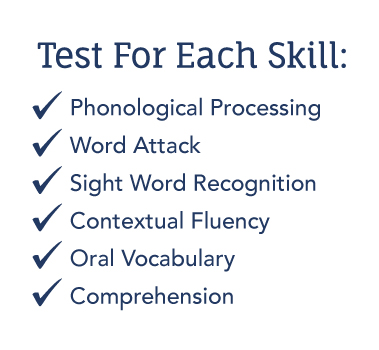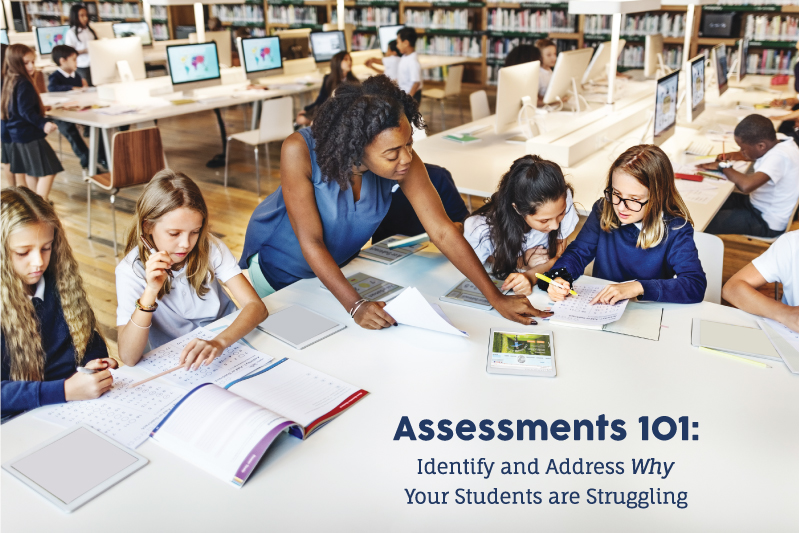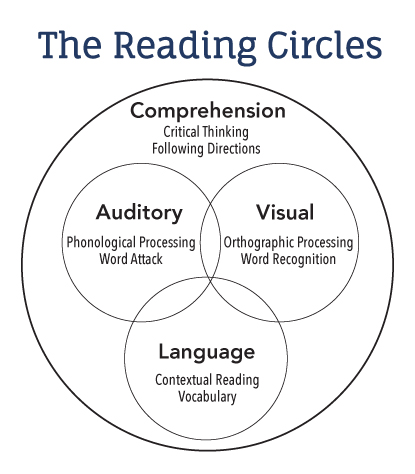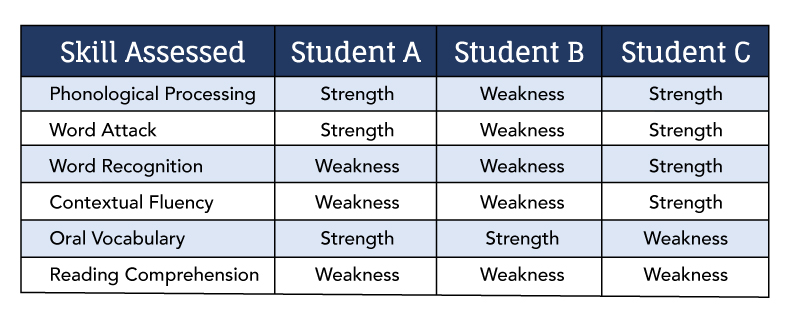Assessments 101: Identify and Address Why Your Students are Struggling
Students in Tiers II and III can spend years receiving services and still struggle in school. Many of these students lack the basic connections needed for reading and comprehension, and the root cause of their weakness may not be addressed with traditional interventions.
This does not have to be the case.
We believe all students can learn how to read and comprehend to their potential.
Reading requires an integration of component parts which must be developed for each individual. While individuals have learning differences, the processes required for reading are not different. The diagram below symbolically represents the subskills which integrate for independent, global reading.
The Primary Cause of Weak Language and Literacy Skills
Reading is an integration of processing skills: phonological processing, word attack, orthographic processing, word recognition, contextual fluency, oral vocabulary, and comprehension. The primary cause of a weakness in language and literacy skills is a weakness in one or more of the following:
Phoneme awareness – The ability to auditorily perceive sounds within words.
Symbol imagery – The ability to create mental imagery for sounds and letters within words.
Concept imagery – The ability to create mental representations for the whole; the dynamic imagery of actions, scenes, movement, etc.
The right instruction can bring these abilities to consciousness and change an individual’s ability to read and comprehend.
Aligning Student Needs and Instruction
Use assessments to identify specific weaknesses (phoneme awareness, symbol imagery, or concept imagery); and turn those weaknesses into strengths by addressing them head-on.
Consider the following for students who have been identified for services:
1. Assessing the Skills Needed for Reading
Review your current testing protocol to ensure there is a clear picture for student ability in each of the component parts of reading. More general assessments will not provide the information necessary to make decisions about instruction.

2. Addressing Individual Learning Needs
It is often easy to spot a student who is having a difficult time with reading. Skill assessments help educators know why their student is struggling as well as provide them with ideas for what to do to help.
For example, a student who struggles with reading may have good word attack skills but poor word recognition (see Student A below), or may have deficits in both areas (Student B). Some students may be struggling with reading comprehension due to a weakness in decoding (Students A and B), or may have a separate comprehension issue (Student C).
3. Instruction That Makes the Connection
Instruction that changes learning is based on an individual’s needs. Use the results from the skills assessed to choose an intervention that will address the cause of your student’s weaknesses. Too often, students are provided with services that only address symptoms. For example, traditional reading remediation programs focus on how to sound out words as well as reading and spelling rules. While these activities have value, they do not affect how a student is processing language.
Lindamood-Bell’s research-validated programs address the imagery-language connection that is a silent partner to cognition and literacy—often the missing piece in helping students close the achievement gap. Our programs are listed below:
Reading and Spelling Programs
Symbol Imagery for Phonological and Orthographic Processing in Reading and Spelling
Lindamood Phoneme Sequencing(LiPS)
Phonemic Awareness for Reading, Spelling, and Speech
Comprehension Programs
Visualizing and Verbalizing(VV)
Concept Imagery for Language Comprehension, Thinking, and Memory
Foundational Development in Concept Imagery, Oral Language Comprehension, and Expression
A note on group instruction:
Each of the sample students in the table above requires a different learning plan; those requirements, along with grade level performance, can be used for appropriate grouping.
Our unique programs can help diverse groups of students learn to read and comprehend to their potential, including students with minor to severe learning challenges and English Language Learners. Lindamood-Bell for Schools provides professional development to individual educators and groups; and we help schools set up RtI models that transform learning. Contact us to learn how to get started: 800-233-1819.








